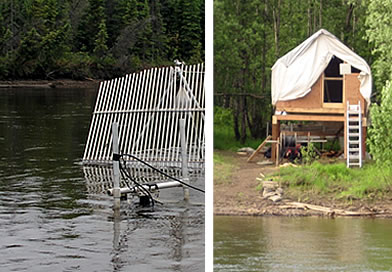
Anvik River
Sonar Tools
Sonar Tools

The Alaska Department of Fish and Game has used the Anvik River sonar project to provide daily summer chum salmon estimates since 1980. ADF&G began sonar operations on the Anvik River using Bendix sonar, but has been using DIDSON at the site since 2007. Each summer, sonar site technicians submerge two DIDSON transducers. Technicians aim the transducers towards the middle of the river and install partial weirs extending from each bank to prevent salmon from swimming behind the transducers undetected.
Along the gradually-sloping right bank, the transducer is placed 33 feet from shore, while along the steeply-sloping left bank the transducer is placed just a few feet from shore. Technicians use the transducers to detect fish out to 65 feet from the right bank transducer and out to 33 feet from the left bank transducer.
The partial weirs and sonar detection ranges cover 60 to 85 percent of the river’s width. Sonar is not used to detect salmon in the middle of the river. As they migrate past the sonar site, summer chum salmon swim close to shore where currents are slower (see energy-conserving behavior study). Approximately 85 percent swim within the first 17 feet of the left bank’s sonar-counting range and within the first 33 feet of the right bank’s sonar-counting range.
Rather than collect sonar data continually, site technicians collect data from each bank for 30 minutes per hour, 24 hours per day. Biologists expand the number of fish counted during each half-hour sampling period to represent a full hour and sum the expanded count to produce an estimate to represent fish passage for the entire day. Research has found the difference in estimates generated while running sonar continually and estimates generated while sampling is very small. But the difference in operational costs is huge (see sampling methods study - PDF File). Anvik sonar site operations begin about June 16 and continue through July 26.
